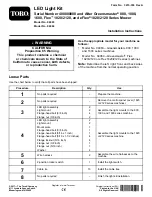
12
Using Stabilizer/Conditioner
Use a fuel stabilizer/conditioner in the machine to provide
the following benefits:
•
Keeps gasoline fresh during storage of 90 days or less.
For longer storage, drain the fuel tank
•
Cleans the engine while it runs
•
Eliminates gum-like varnish buildup in the fuel system,
which causes hard starting
Important
Do not use fuel additives containing
methanol or ethanol.
Add the correct amount of gas stabilizer/conditioner to the
gas.
Note: A fuel stabilizer/conditioner is most effective when
mixed with fresh gasoline. To minimize the chance of
varnish deposits in the fuel system, use fuel stabilizer at all
times.
Filling the Fuel Tank
1. Shut the engine off and set the parking brake.
2. Clean around the fuel tank cap and remove the cap. Add
unleaded regular gasoline to the fuel tank until the level
is 1/4 to 1/2 in. (6 to 13 mm) below the bottom of the
filler neck. This space in the tank allows gasoline to
expand. Do not fill the fuel tank completely full.
3. Install the fuel tank cap securely. Wipe up any gasoline
that may have spilled.
Checking the Engine Oil Level
Before you start the engine and use the machine, check the
oil level in the engine crankcase; refer to Checking the Oil
Level, page 20.
Operation
Note: Determine the left and right sides of the machine
from the normal operating position.
Think Safety First
Please carefully read all of the safety instructions and
decals in the safety section. Knowing this information
could help you, your family, pets or bystanders avoid
injury.
Controls
Become familiar with all of the controls (Fig. 2) before you
start the engine and operate the machine.
12
11
1
2
3
4
5
6
7
8
9
10
m–4300
Figure 2
1.
Steering wheel
2.
Light switch—on/off
(selected models)
3.
Ignition switch
4.
Clutch/brake pedal
5.
Blade control (PTO)
6.
Ground speed selector
7.
Height-of-cut lever
(deck lift)
8.
Parking brake lever
9.
Throttle lever
10. Hood opening
11. Operating-in-reverse light
12. KeyChoice
switch













































